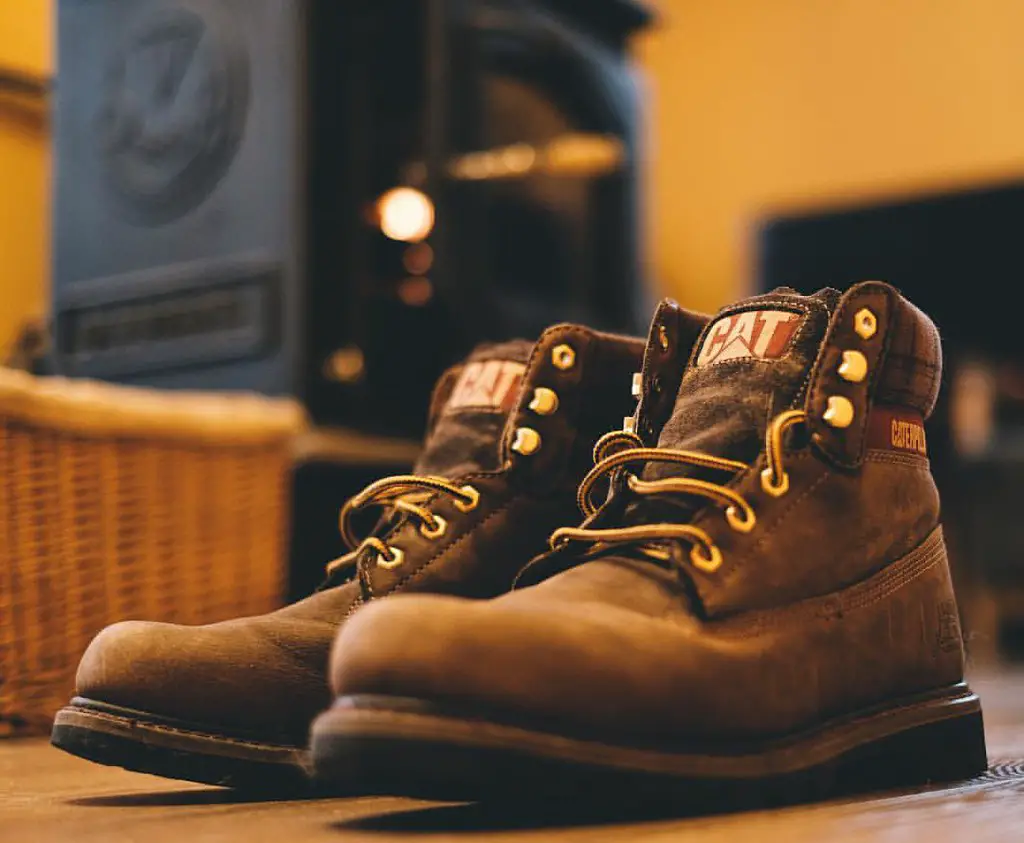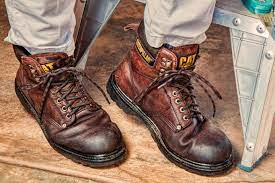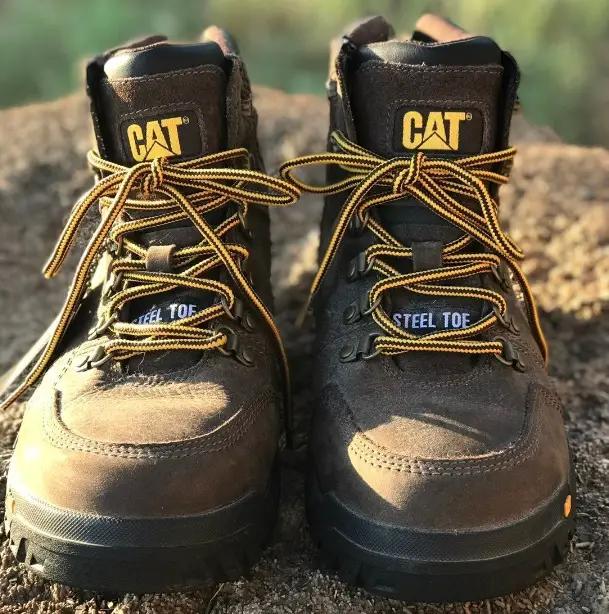If you’re planning on hiking, having the right boots is of critical importance. Hiking demands strong footwear that provides the support and comfort you need. Not everyone hikes often enough to have a dedicated pair of hiking boots, and you may be wondering if Caterpillar boots are good for hiking.
While you absolutely can hike in Caterpillar boots, they are not intended to be hiking boots. Caterpillar boots are best for short and simple hikes due to their weight and lack of comfort and traction.
Caterpillar boots were originally designed for workplace use in the construction, farming, and mining industries with an emphasis on durability, and debuted in 1925.
Their distinctive look, tough performance, and versatility is what has kept them so popular for so long.
How well Caterpillar boots will work for you while hiking depends on a few different factors, which we’ll break down for you below.
Note that while Caterpillar has begun making boots specifically for hiking in recent years, most Caterpillar boots are work boots, which is what we’ll be focusing on in this article.

Caterpillar Boots Vs Hiking Boots
There are a few key differences between hiking boots and Caterpillar boots, and choosing the right one can make a huge impact on your experience depending on which activity you’re doing.
Let’s break down the major points to consider when choosing hiking boots vs work boots.
Weight
The weight of a hiking boot is much lighter than a Caterpillar boot, and this weight can really make a huge impact on the enjoyability of your hike.
Caterpillar boots are designed for safety and injury prevention, so features like steel toes are often included, which add extra weight.
Hiking boots are usually equipped with rubber toe caps which will still provide the bump and abrasion protection you need.
The added weight of Caterpillar boots will add to the amount of energy you spend on your hike, so pay close attention to the total weight if using a work boot on your hike.
Traction
Most hiking boots include grooves and patterns that are designed to provide extra grip or traction on a variety of surfaces.
Caterpillar boots usually feature simpler sole patterns with shallower indentations, offering a bit of slip resistance, but not nearly the amount of grip that most hiking boots will offer.
Consider the type of trails you’ll be hiking, along with what ground conditions and weather you’ll be hiking in, as hiking boots offer much better performance – especially in wet, snowy, or muddy conditions.
Flexibility
The soles of Caterpillar boots are designed with protection and puncture-resistance in mind.
This typically means that they have stiff rubber soles for safety.
Although this is a great safety feature, it’s not such a great feature when hiking.
The rigid soles of Caterpillar boots will reduce your grip on uneven terrain, affecting your stability.
Comfort
Hiking boots are designed to keep you comfortable over long distances, and the materials hiking boots are made from are designed to absorb shocks as you hike.
Simply put, most Caterpillar boots will not provide extended comfort for longer hikes.
Waterproofing
Depending on the terrain you’ll be hiking, you may encounter streams or other bodies of water that you’ll be crossing.
Most of today’s hiking boots offer waterproofing and quick-drying capabilities, allowing the boot to dry as you continue to hike.
Most Caterpillar boots may be water resistant, but will absorb more water and take longer to dry than hiking boots will.
Ankle Support
Ankle support in hiking boots vs Caterpillar boots is a very important factor to consider, especially if you’ll be carrying a backpack.
Depending on your needs, hiking boots can come in versions that support you with a low, mid, or high-cut profile, where Caterpillar boots almost exclusively offer mid or high-cut protection.
What Features Should I Look For In Good Hiking Boots?
The three key features you should look for in a good hiking boot are the type of hiking boot, the fit, and the components the boots are made of.
We’ll walk through each below.
Types of Caterpillar Boots For Hiking
There are many types of hiking boots available, and all the options can be overwhelming. Make sure to pick the right type of hiking boot for your intended use.
Let’s break down the most common types of hiking boots you’ll encounter while looking for your next pair.
Hiking Shoes
These low-cut models offer flexible midsoles and are best used for day hiking.
Day Hiking Boots
Day hiking boots come in mid and high-cut options and are best for day hiking or shorter backpacking trips with lighter loads.
They’re easy to break in and have decent flex, but they don’t offer as much support as proper backpacking boots.
Backpacking Boots
You’ll want a pair of proper backpacking boots if you’re doing trips spanning several days, or going deep into the wilderness.
These boots usually come in high cut only, wrapping around the ankle to give extra support.
Backpacking boots are durable and offer stiffer midsoles than lighter boot options, and have the support you’ll need both off and on the trail.
Waterproof vs Non-Waterproof
Hiking boots come in both waterproof and non-waterproof options. Waterproof boots are great at resisting moisture, but are less breathable.
The choice is up to you, but be sure to select the right option for your needs.
If you’ll be hiking in snow, crossing streams or creeks, or otherwise getting outside in wet conditions, you’ll absolutely want to opt for a waterproof hiking boot.
If you don’t plan on hiking in these conditions, you can go non-waterproof.
Minimalist, Barefoot, and Zero-Drop Hiking Shoes
These shoes are intended to minimize padding and support to allow you to get as close as possible to a barefoot experience while still providing some protection and grip.
Choosing this type of hiking shoe is largely up to personal preference, and you’ll need to try them on to see if a barefoot-feel is right for you.

What To Know About Hiking Boot Components
Hiking Boot Uppers
What material your boot is made from determines critical factors like weight, durability, water resistance, and breathability. Read on to see what materials you’ll come across when shopping for hiking boots.
Full Grain Leather
-Full-grain leather is durable and resists abrasions, and also offers great water resistance. You’ll typically find full-grain leather used in backpacking boots.
-Full-grain leather is not as breathable or as light as split-grain leather or nylon. Also, full-grain leather boots take longer to break in.
Split Grain Leather
-Split-grain leather is usually combined with nylon to offer a breathable and lightweight hiking boot.
-Split-grain leather will result in a lower cost boot, but also is less resistant to water and scuffs.
Nubuck Leather
-Nubuck leather is simply full-grain leather that has been buffed to look like suede.
-Nubuck is durable and resists abrasions and moisture, and is flexible too.
-Expect nubuck leather hiking boots to take longer to break in.
Synthetics
-Nylon, polyester, and synthetic leather are all materials used in many of today’s hiking boots.
-Compared to leather, synthetics cost less, break in more quickly, are more lightweight, and dry faster.
-The trade-off with synthetics is that they can wear down faster than leather.
Waterproof Membranes
-Waterproof hiking boots feature breathable and waterproof membranes (like Gore-Tex and eVent) to keep water off your feet.
-You’ll be sacrificing breathability with waterproof hiking boots, which can lead to sweaty feet in warmer hiking conditions, but waterproofing is a must if you’ll be doing longer hikes in wet conditions.
Vegan Materials
-Vegan materials are made without any animal ingredients. Modern vegan hiking boots are beefy enough to provide plenty of protection and come in waterproof options.
Insulation
-Some hiking boots offer added synthetic insulation to provide additional warmth, which is a plus if you’ll be hiking in snow or colder conditions.
Hiking Boot Midsoles
The boot’s midsole provides cushioning for the foot and helps to absorb shocks.
The midsole provides stiffness to the boot, which can provide better comfort and stability when hiking on Caterpillar and uneven terrain.
Most midsoles of Caterpillar boots are made from either EVA (ethylene vinyl acetate) or polyurethane.
EVA Midsoles
-EVA is lighter, less expensive, and provides more cushioning than polyurethane, and comes in different densities to provide more support in needed areas within the boot.
Polyurethane Midsoles
-Polyurethane is more durable and firmer than EVA, making it a common choice in backpacking and mountaineering boots.
Hiking Boot Internal Support
Shanks
-Shanks are inserts between 3-5mm thick that are placed between the hiking boot’s outsole and midsole to provide stiffness and load-bearing.
-Shanks vary in length, ranging from covering half the boot or all the way to the entire length of the boot.
Plates
-Plates are semi-flexible, thin inserts that may be found in boots either alone or in conjunction with shanks.
-Plates allow additional foot protection against uneven terrain like tree roots or rocks.
Hiking Boot Outsoles
Rubber is the main material used on nearly all outsoles of hiking boots. Sometimes, additives like carbon are included to increase the rubber’s hardness.
This hardness is great for durability, but can get slick on wet terrain, especially off trail.
Lug Pattern Outsoles
-Lugs are bumps on the outsole designed to provide traction. Mountaineering and backpacking boots feature deeper and thicker lugs to increase grip.
-Wide-spaced lugs help to shed mud and offer good traction.
Heel Brake Section
-The heel brake section of a hiking boot’s outsole is specially designed to increase heel grip to reduce your chances of sliding while hiking steep declines.
-Opt for a hiking boot with a heel brake on the outsole if you plan on hiking steep terrain.
Crampon Compatibility
Crampons are hiking boot attachments that improve mobility on snow or ice, typically in ice climbing.
If that’s something you’ll be doing, be sure that you pick a boot that offers compatibility with crampons.

Tips For Hiking In Caterpillar Boots
If you’re looking forward to sporting your Caterpillar boots on your next hike, follow these simple tips to ensure you have the best experience possible.
Make Sure Your Caterpillar Boots Are Broken In
Take it from us: you never, ever want to go on a hike wearing brand new Caterpillar boots.
It takes a little time to break them in, and the discomfort you’ll experience won’t be worth the great style you’re sporting.
Test For Proper Fit – And Lace Up Right
Make sure your feet can’t move too much side-to-side and there are no areas where you feel pinching in your boots. Also pay attention to your toes inside the boot – they should never touch the front, and if they do, you risk bumping them and getting black toenail (no fun!).
Once you know the fit is good, then experiment with lacing them up at different tightness levels to make sure you are minimizing friction and giving your ankles good support.
Wear Proper Hiking Socks
If you’re set on wearing your Caterpillar boots while hiking, do yourself a huge favor and wear a pair of well-fitting hiking socks. If you’ll be going on a longer hike, bring an extra pair along to change into for prolonged comfort.
Waterproof Your Caterpillar Boots
If you’ll be hiking in rain, mud, or crossing small bodies of water like creeks or streams, you’ll definitely want to plan ahead by waterproofing your Caterpillar boots.
Not only will this keep your feet dry, but you’ll also keep your boots looking great long-term. We recommend Nikwax Leather and Fabric Waterproofing Spray for waterproofing Caterpillar boots.
Hiking Boots vs Caterpillar Boots – Frequently Asked Questions
You can certainly hike in your Caterpillar boots – we typically advise that a hike here or there is fine, and the flatter the trail, the better.
If you find yourself hiking more than once or twice a year, it’s a great idea to invest in some hiking boots.
Typically, short and simple hikes are fine for using Caterpillar boots.
If you’ll be crossing water, or hiking on muddy or wet terrain, we highly recommend using hiking boots.
Generally, hiking boots are not OSHA approved – OSHA and ATSM standards are specific in nature to work environments, and thus don’t apply to hiking boots.
However, that doesn’t mean that hiking boots aren’t meant to protect your feet.
Hiking boots offer sole protection, grip, toe protection, and ankle support, which are the key safety features you should consider when choosing a hiking boot.
Are Caterpillar Boots Good For Hiking? Wrapping Things Up
Although we don’t recommend Caterpillar boots for serious hiking, you’ll be just fine to use them on short and simple hikes – just be sure to wear hiking socks and make sure those Caterpillar boots are broken in before you go.
Ultimately, if you see yourself hiking more than once or twice a year, it’s time to pick up a pair of dedicated hiking boots.
The traction, weight, flexibility, and waterproof features of hiking boots will make your hikes more enjoyable and allow you to stay on the trail longer.
Have any stories from hiking in Caterpillar boots? Please share them below, and let us know if you have any questions.
If you’re looking to get further into hiking, take a look at our top pick for the best men’s hiking boots under $100, the best women’s hiking boots under $100, and our guide to how should hiking boots fit.
As always, have fun and enjoy your hike!

